HRM Essay: Factors Influencing Performance Related Pay in HRM
VerifiedAdded on 2023/01/23
|9
|3107
|20
Essay
AI Summary
This essay delves into the realm of human resource management, focusing on human resource policies, processes, and practices and their impact on organizational strategies. It specifically examines the concept of individual performance-related pay (PRP), explaining how it links salary progression to performance assessments and predetermined objectives, and how this approach can stimulate higher levels of employee performance. The essay explores the positive and negative factors influencing employee motivation, considering aspects such as occupation type, income standards, cultural values, and individual differences. It further investigates the relationship between line managers and human resource managers, and strategies to enhance these relationships. The discussion references scholarly resources to provide a comprehensive understanding of performance pay, its effects on employee performance, and its effective implementation within organizations, including the importance of reward and performance management systems and the factors that affect the effectiveness of PRP.
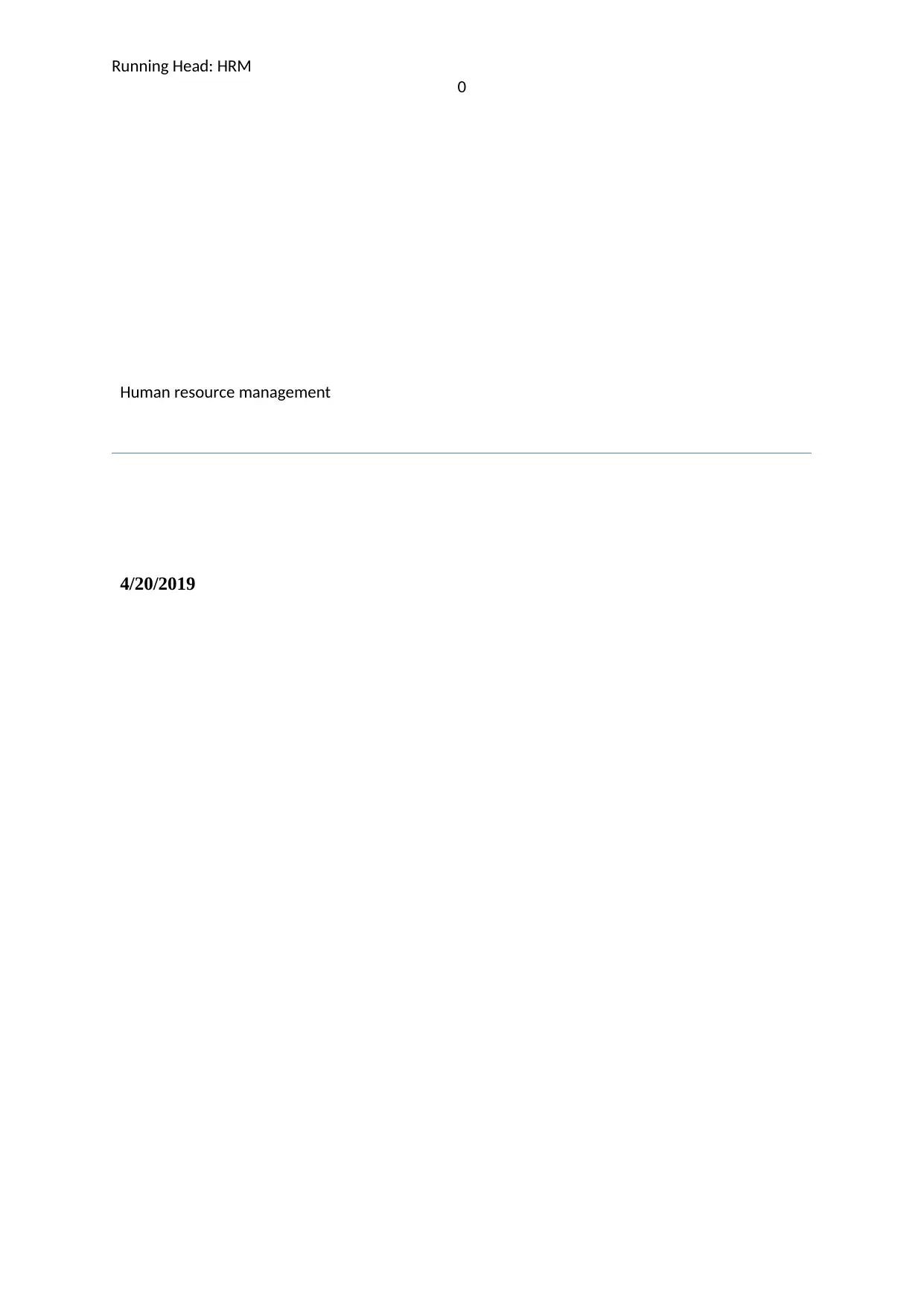
Running Head: HRM
0
Human resource management
4/20/2019
0
Human resource management
4/20/2019
Paraphrase This Document
Need a fresh take? Get an instant paraphrase of this document with our AI Paraphraser
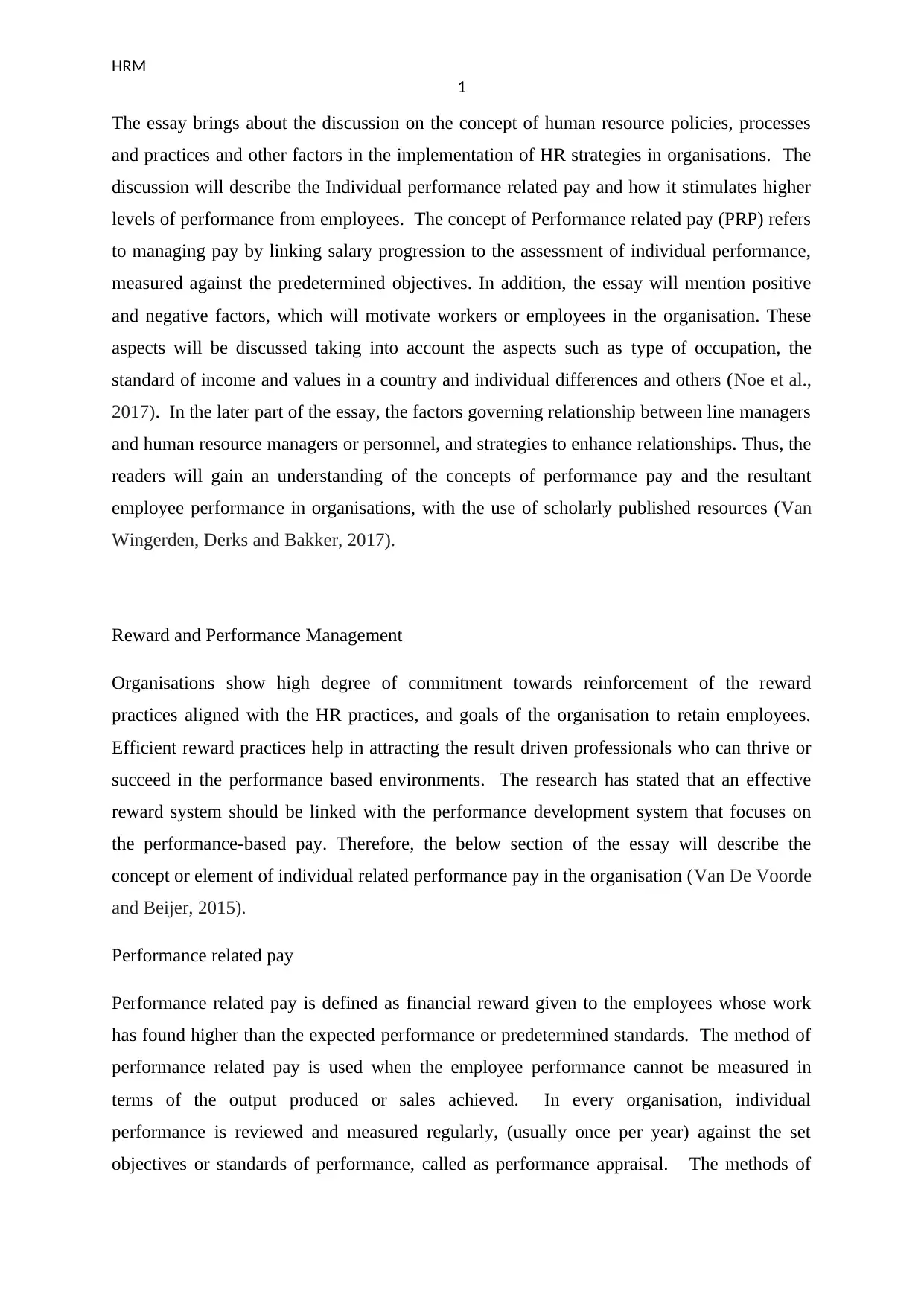
HRM
1
The essay brings about the discussion on the concept of human resource policies, processes
and practices and other factors in the implementation of HR strategies in organisations. The
discussion will describe the Individual performance related pay and how it stimulates higher
levels of performance from employees. The concept of Performance related pay (PRP) refers
to managing pay by linking salary progression to the assessment of individual performance,
measured against the predetermined objectives. In addition, the essay will mention positive
and negative factors, which will motivate workers or employees in the organisation. These
aspects will be discussed taking into account the aspects such as type of occupation, the
standard of income and values in a country and individual differences and others (Noe et al.,
2017). In the later part of the essay, the factors governing relationship between line managers
and human resource managers or personnel, and strategies to enhance relationships. Thus, the
readers will gain an understanding of the concepts of performance pay and the resultant
employee performance in organisations, with the use of scholarly published resources (Van
Wingerden, Derks and Bakker, 2017).
Reward and Performance Management
Organisations show high degree of commitment towards reinforcement of the reward
practices aligned with the HR practices, and goals of the organisation to retain employees.
Efficient reward practices help in attracting the result driven professionals who can thrive or
succeed in the performance based environments. The research has stated that an effective
reward system should be linked with the performance development system that focuses on
the performance-based pay. Therefore, the below section of the essay will describe the
concept or element of individual related performance pay in the organisation (Van De Voorde
and Beijer, 2015).
Performance related pay
Performance related pay is defined as financial reward given to the employees whose work
has found higher than the expected performance or predetermined standards. The method of
performance related pay is used when the employee performance cannot be measured in
terms of the output produced or sales achieved. In every organisation, individual
performance is reviewed and measured regularly, (usually once per year) against the set
objectives or standards of performance, called as performance appraisal. The methods of
1
The essay brings about the discussion on the concept of human resource policies, processes
and practices and other factors in the implementation of HR strategies in organisations. The
discussion will describe the Individual performance related pay and how it stimulates higher
levels of performance from employees. The concept of Performance related pay (PRP) refers
to managing pay by linking salary progression to the assessment of individual performance,
measured against the predetermined objectives. In addition, the essay will mention positive
and negative factors, which will motivate workers or employees in the organisation. These
aspects will be discussed taking into account the aspects such as type of occupation, the
standard of income and values in a country and individual differences and others (Noe et al.,
2017). In the later part of the essay, the factors governing relationship between line managers
and human resource managers or personnel, and strategies to enhance relationships. Thus, the
readers will gain an understanding of the concepts of performance pay and the resultant
employee performance in organisations, with the use of scholarly published resources (Van
Wingerden, Derks and Bakker, 2017).
Reward and Performance Management
Organisations show high degree of commitment towards reinforcement of the reward
practices aligned with the HR practices, and goals of the organisation to retain employees.
Efficient reward practices help in attracting the result driven professionals who can thrive or
succeed in the performance based environments. The research has stated that an effective
reward system should be linked with the performance development system that focuses on
the performance-based pay. Therefore, the below section of the essay will describe the
concept or element of individual related performance pay in the organisation (Van De Voorde
and Beijer, 2015).
Performance related pay
Performance related pay is defined as financial reward given to the employees whose work
has found higher than the expected performance or predetermined standards. The method of
performance related pay is used when the employee performance cannot be measured in
terms of the output produced or sales achieved. In every organisation, individual
performance is reviewed and measured regularly, (usually once per year) against the set
objectives or standards of performance, called as performance appraisal. The methods of
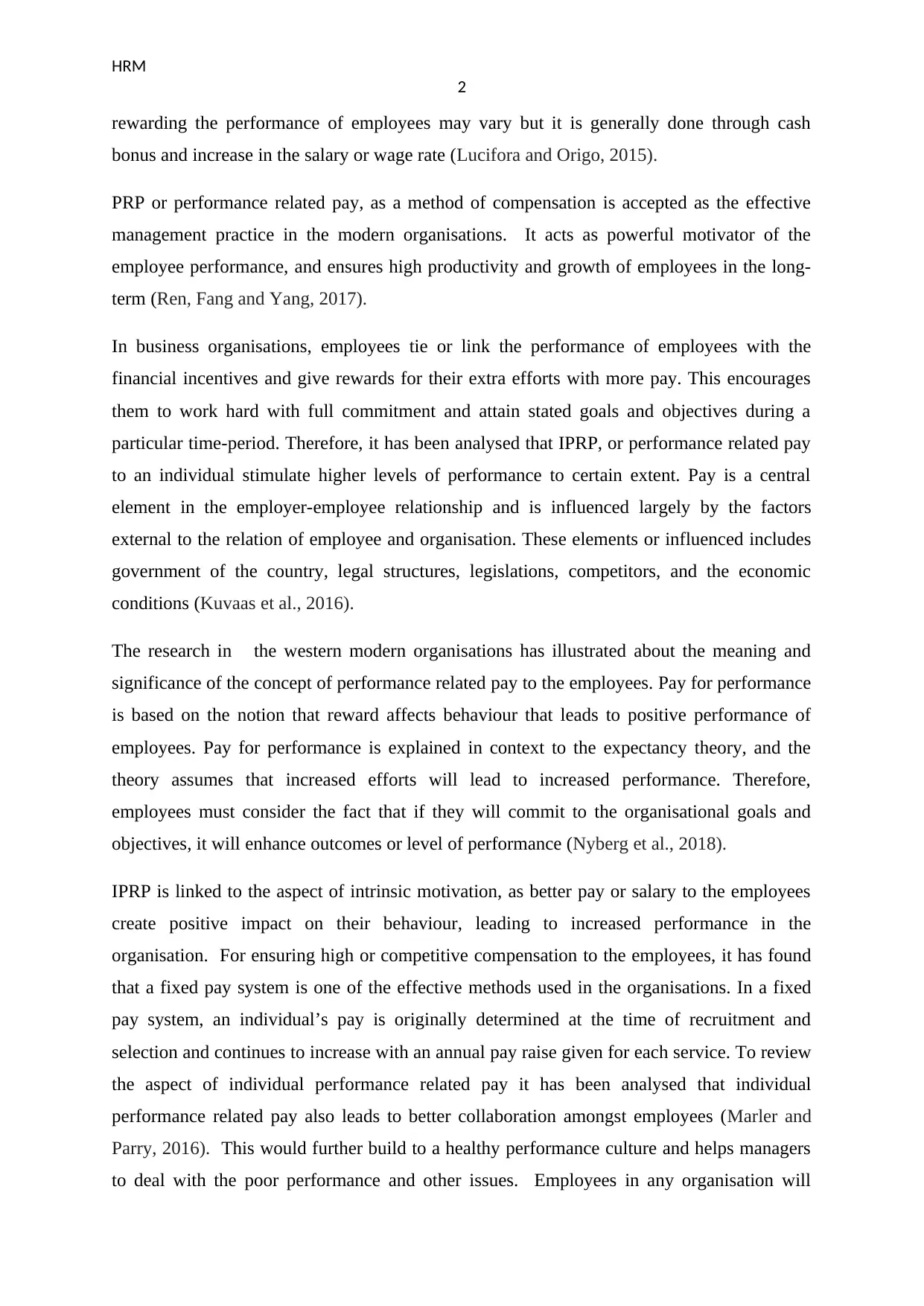
HRM
2
rewarding the performance of employees may vary but it is generally done through cash
bonus and increase in the salary or wage rate (Lucifora and Origo, 2015).
PRP or performance related pay, as a method of compensation is accepted as the effective
management practice in the modern organisations. It acts as powerful motivator of the
employee performance, and ensures high productivity and growth of employees in the long-
term (Ren, Fang and Yang, 2017).
In business organisations, employees tie or link the performance of employees with the
financial incentives and give rewards for their extra efforts with more pay. This encourages
them to work hard with full commitment and attain stated goals and objectives during a
particular time-period. Therefore, it has been analysed that IPRP, or performance related pay
to an individual stimulate higher levels of performance to certain extent. Pay is a central
element in the employer-employee relationship and is influenced largely by the factors
external to the relation of employee and organisation. These elements or influenced includes
government of the country, legal structures, legislations, competitors, and the economic
conditions (Kuvaas et al., 2016).
The research in the western modern organisations has illustrated about the meaning and
significance of the concept of performance related pay to the employees. Pay for performance
is based on the notion that reward affects behaviour that leads to positive performance of
employees. Pay for performance is explained in context to the expectancy theory, and the
theory assumes that increased efforts will lead to increased performance. Therefore,
employees must consider the fact that if they will commit to the organisational goals and
objectives, it will enhance outcomes or level of performance (Nyberg et al., 2018).
IPRP is linked to the aspect of intrinsic motivation, as better pay or salary to the employees
create positive impact on their behaviour, leading to increased performance in the
organisation. For ensuring high or competitive compensation to the employees, it has found
that a fixed pay system is one of the effective methods used in the organisations. In a fixed
pay system, an individual’s pay is originally determined at the time of recruitment and
selection and continues to increase with an annual pay raise given for each service. To review
the aspect of individual performance related pay it has been analysed that individual
performance related pay also leads to better collaboration amongst employees (Marler and
Parry, 2016). This would further build to a healthy performance culture and helps managers
to deal with the poor performance and other issues. Employees in any organisation will
2
rewarding the performance of employees may vary but it is generally done through cash
bonus and increase in the salary or wage rate (Lucifora and Origo, 2015).
PRP or performance related pay, as a method of compensation is accepted as the effective
management practice in the modern organisations. It acts as powerful motivator of the
employee performance, and ensures high productivity and growth of employees in the long-
term (Ren, Fang and Yang, 2017).
In business organisations, employees tie or link the performance of employees with the
financial incentives and give rewards for their extra efforts with more pay. This encourages
them to work hard with full commitment and attain stated goals and objectives during a
particular time-period. Therefore, it has been analysed that IPRP, or performance related pay
to an individual stimulate higher levels of performance to certain extent. Pay is a central
element in the employer-employee relationship and is influenced largely by the factors
external to the relation of employee and organisation. These elements or influenced includes
government of the country, legal structures, legislations, competitors, and the economic
conditions (Kuvaas et al., 2016).
The research in the western modern organisations has illustrated about the meaning and
significance of the concept of performance related pay to the employees. Pay for performance
is based on the notion that reward affects behaviour that leads to positive performance of
employees. Pay for performance is explained in context to the expectancy theory, and the
theory assumes that increased efforts will lead to increased performance. Therefore,
employees must consider the fact that if they will commit to the organisational goals and
objectives, it will enhance outcomes or level of performance (Nyberg et al., 2018).
IPRP is linked to the aspect of intrinsic motivation, as better pay or salary to the employees
create positive impact on their behaviour, leading to increased performance in the
organisation. For ensuring high or competitive compensation to the employees, it has found
that a fixed pay system is one of the effective methods used in the organisations. In a fixed
pay system, an individual’s pay is originally determined at the time of recruitment and
selection and continues to increase with an annual pay raise given for each service. To review
the aspect of individual performance related pay it has been analysed that individual
performance related pay also leads to better collaboration amongst employees (Marler and
Parry, 2016). This would further build to a healthy performance culture and helps managers
to deal with the poor performance and other issues. Employees in any organisation will
⊘ This is a preview!⊘
Do you want full access?
Subscribe today to unlock all pages.

Trusted by 1+ million students worldwide
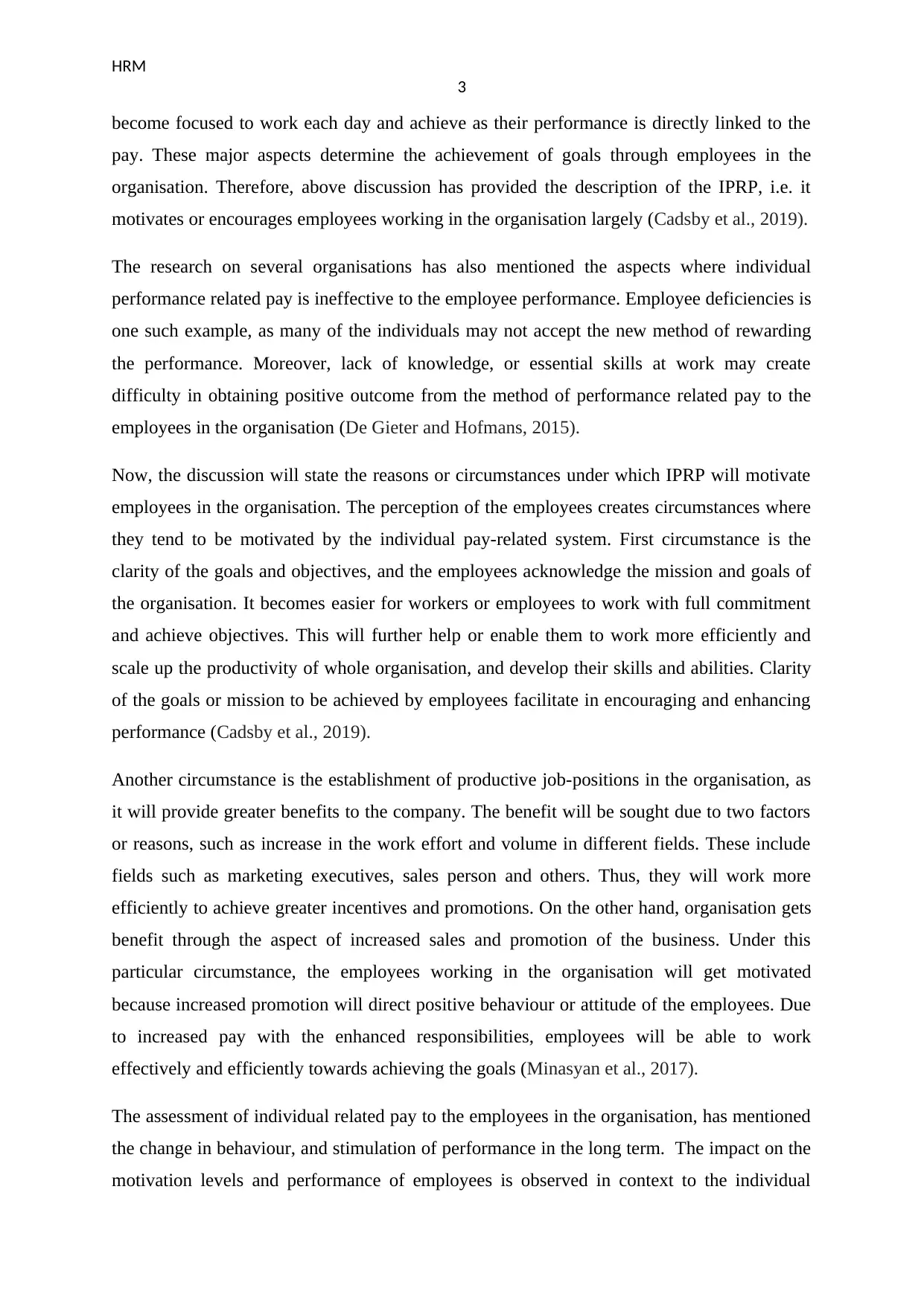
HRM
3
become focused to work each day and achieve as their performance is directly linked to the
pay. These major aspects determine the achievement of goals through employees in the
organisation. Therefore, above discussion has provided the description of the IPRP, i.e. it
motivates or encourages employees working in the organisation largely (Cadsby et al., 2019).
The research on several organisations has also mentioned the aspects where individual
performance related pay is ineffective to the employee performance. Employee deficiencies is
one such example, as many of the individuals may not accept the new method of rewarding
the performance. Moreover, lack of knowledge, or essential skills at work may create
difficulty in obtaining positive outcome from the method of performance related pay to the
employees in the organisation (De Gieter and Hofmans, 2015).
Now, the discussion will state the reasons or circumstances under which IPRP will motivate
employees in the organisation. The perception of the employees creates circumstances where
they tend to be motivated by the individual pay-related system. First circumstance is the
clarity of the goals and objectives, and the employees acknowledge the mission and goals of
the organisation. It becomes easier for workers or employees to work with full commitment
and achieve objectives. This will further help or enable them to work more efficiently and
scale up the productivity of whole organisation, and develop their skills and abilities. Clarity
of the goals or mission to be achieved by employees facilitate in encouraging and enhancing
performance (Cadsby et al., 2019).
Another circumstance is the establishment of productive job-positions in the organisation, as
it will provide greater benefits to the company. The benefit will be sought due to two factors
or reasons, such as increase in the work effort and volume in different fields. These include
fields such as marketing executives, sales person and others. Thus, they will work more
efficiently to achieve greater incentives and promotions. On the other hand, organisation gets
benefit through the aspect of increased sales and promotion of the business. Under this
particular circumstance, the employees working in the organisation will get motivated
because increased promotion will direct positive behaviour or attitude of the employees. Due
to increased pay with the enhanced responsibilities, employees will be able to work
effectively and efficiently towards achieving the goals (Minasyan et al., 2017).
The assessment of individual related pay to the employees in the organisation, has mentioned
the change in behaviour, and stimulation of performance in the long term. The impact on the
motivation levels and performance of employees is observed in context to the individual
3
become focused to work each day and achieve as their performance is directly linked to the
pay. These major aspects determine the achievement of goals through employees in the
organisation. Therefore, above discussion has provided the description of the IPRP, i.e. it
motivates or encourages employees working in the organisation largely (Cadsby et al., 2019).
The research on several organisations has also mentioned the aspects where individual
performance related pay is ineffective to the employee performance. Employee deficiencies is
one such example, as many of the individuals may not accept the new method of rewarding
the performance. Moreover, lack of knowledge, or essential skills at work may create
difficulty in obtaining positive outcome from the method of performance related pay to the
employees in the organisation (De Gieter and Hofmans, 2015).
Now, the discussion will state the reasons or circumstances under which IPRP will motivate
employees in the organisation. The perception of the employees creates circumstances where
they tend to be motivated by the individual pay-related system. First circumstance is the
clarity of the goals and objectives, and the employees acknowledge the mission and goals of
the organisation. It becomes easier for workers or employees to work with full commitment
and achieve objectives. This will further help or enable them to work more efficiently and
scale up the productivity of whole organisation, and develop their skills and abilities. Clarity
of the goals or mission to be achieved by employees facilitate in encouraging and enhancing
performance (Cadsby et al., 2019).
Another circumstance is the establishment of productive job-positions in the organisation, as
it will provide greater benefits to the company. The benefit will be sought due to two factors
or reasons, such as increase in the work effort and volume in different fields. These include
fields such as marketing executives, sales person and others. Thus, they will work more
efficiently to achieve greater incentives and promotions. On the other hand, organisation gets
benefit through the aspect of increased sales and promotion of the business. Under this
particular circumstance, the employees working in the organisation will get motivated
because increased promotion will direct positive behaviour or attitude of the employees. Due
to increased pay with the enhanced responsibilities, employees will be able to work
effectively and efficiently towards achieving the goals (Minasyan et al., 2017).
The assessment of individual related pay to the employees in the organisation, has mentioned
the change in behaviour, and stimulation of performance in the long term. The impact on the
motivation levels and performance of employees is observed in context to the individual
Paraphrase This Document
Need a fresh take? Get an instant paraphrase of this document with our AI Paraphraser
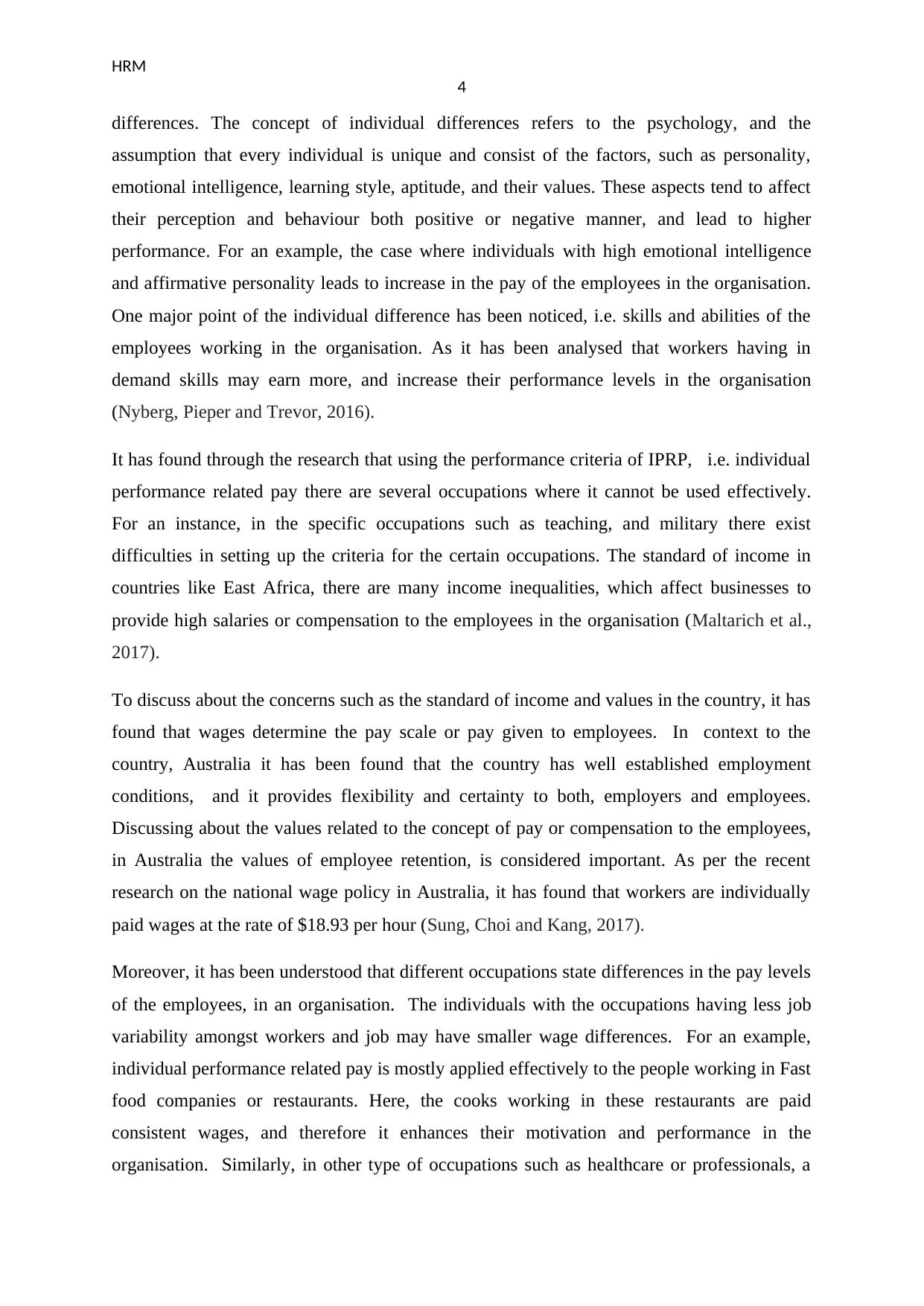
HRM
4
differences. The concept of individual differences refers to the psychology, and the
assumption that every individual is unique and consist of the factors, such as personality,
emotional intelligence, learning style, aptitude, and their values. These aspects tend to affect
their perception and behaviour both positive or negative manner, and lead to higher
performance. For an example, the case where individuals with high emotional intelligence
and affirmative personality leads to increase in the pay of the employees in the organisation.
One major point of the individual difference has been noticed, i.e. skills and abilities of the
employees working in the organisation. As it has been analysed that workers having in
demand skills may earn more, and increase their performance levels in the organisation
(Nyberg, Pieper and Trevor, 2016).
It has found through the research that using the performance criteria of IPRP, i.e. individual
performance related pay there are several occupations where it cannot be used effectively.
For an instance, in the specific occupations such as teaching, and military there exist
difficulties in setting up the criteria for the certain occupations. The standard of income in
countries like East Africa, there are many income inequalities, which affect businesses to
provide high salaries or compensation to the employees in the organisation (Maltarich et al.,
2017).
To discuss about the concerns such as the standard of income and values in the country, it has
found that wages determine the pay scale or pay given to employees. In context to the
country, Australia it has been found that the country has well established employment
conditions, and it provides flexibility and certainty to both, employers and employees.
Discussing about the values related to the concept of pay or compensation to the employees,
in Australia the values of employee retention, is considered important. As per the recent
research on the national wage policy in Australia, it has found that workers are individually
paid wages at the rate of $18.93 per hour (Sung, Choi and Kang, 2017).
Moreover, it has been understood that different occupations state differences in the pay levels
of the employees, in an organisation. The individuals with the occupations having less job
variability amongst workers and job may have smaller wage differences. For an example,
individual performance related pay is mostly applied effectively to the people working in Fast
food companies or restaurants. Here, the cooks working in these restaurants are paid
consistent wages, and therefore it enhances their motivation and performance in the
organisation. Similarly, in other type of occupations such as healthcare or professionals, a
4
differences. The concept of individual differences refers to the psychology, and the
assumption that every individual is unique and consist of the factors, such as personality,
emotional intelligence, learning style, aptitude, and their values. These aspects tend to affect
their perception and behaviour both positive or negative manner, and lead to higher
performance. For an example, the case where individuals with high emotional intelligence
and affirmative personality leads to increase in the pay of the employees in the organisation.
One major point of the individual difference has been noticed, i.e. skills and abilities of the
employees working in the organisation. As it has been analysed that workers having in
demand skills may earn more, and increase their performance levels in the organisation
(Nyberg, Pieper and Trevor, 2016).
It has found through the research that using the performance criteria of IPRP, i.e. individual
performance related pay there are several occupations where it cannot be used effectively.
For an instance, in the specific occupations such as teaching, and military there exist
difficulties in setting up the criteria for the certain occupations. The standard of income in
countries like East Africa, there are many income inequalities, which affect businesses to
provide high salaries or compensation to the employees in the organisation (Maltarich et al.,
2017).
To discuss about the concerns such as the standard of income and values in the country, it has
found that wages determine the pay scale or pay given to employees. In context to the
country, Australia it has been found that the country has well established employment
conditions, and it provides flexibility and certainty to both, employers and employees.
Discussing about the values related to the concept of pay or compensation to the employees,
in Australia the values of employee retention, is considered important. As per the recent
research on the national wage policy in Australia, it has found that workers are individually
paid wages at the rate of $18.93 per hour (Sung, Choi and Kang, 2017).
Moreover, it has been understood that different occupations state differences in the pay levels
of the employees, in an organisation. The individuals with the occupations having less job
variability amongst workers and job may have smaller wage differences. For an example,
individual performance related pay is mostly applied effectively to the people working in Fast
food companies or restaurants. Here, the cooks working in these restaurants are paid
consistent wages, and therefore it enhances their motivation and performance in the
organisation. Similarly, in other type of occupations such as healthcare or professionals, a
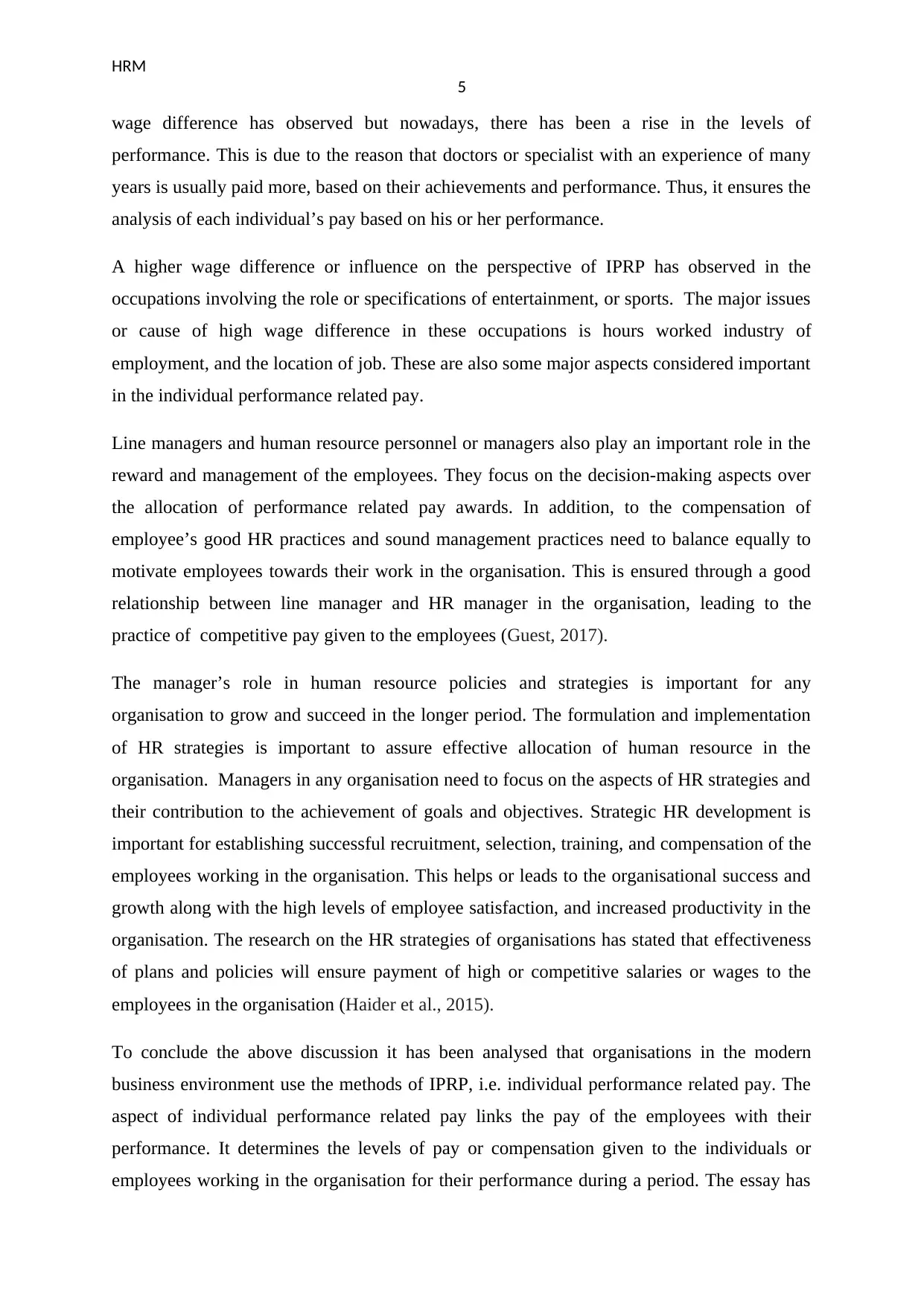
HRM
5
wage difference has observed but nowadays, there has been a rise in the levels of
performance. This is due to the reason that doctors or specialist with an experience of many
years is usually paid more, based on their achievements and performance. Thus, it ensures the
analysis of each individual’s pay based on his or her performance.
A higher wage difference or influence on the perspective of IPRP has observed in the
occupations involving the role or specifications of entertainment, or sports. The major issues
or cause of high wage difference in these occupations is hours worked industry of
employment, and the location of job. These are also some major aspects considered important
in the individual performance related pay.
Line managers and human resource personnel or managers also play an important role in the
reward and management of the employees. They focus on the decision-making aspects over
the allocation of performance related pay awards. In addition, to the compensation of
employee’s good HR practices and sound management practices need to balance equally to
motivate employees towards their work in the organisation. This is ensured through a good
relationship between line manager and HR manager in the organisation, leading to the
practice of competitive pay given to the employees (Guest, 2017).
The manager’s role in human resource policies and strategies is important for any
organisation to grow and succeed in the longer period. The formulation and implementation
of HR strategies is important to assure effective allocation of human resource in the
organisation. Managers in any organisation need to focus on the aspects of HR strategies and
their contribution to the achievement of goals and objectives. Strategic HR development is
important for establishing successful recruitment, selection, training, and compensation of the
employees working in the organisation. This helps or leads to the organisational success and
growth along with the high levels of employee satisfaction, and increased productivity in the
organisation. The research on the HR strategies of organisations has stated that effectiveness
of plans and policies will ensure payment of high or competitive salaries or wages to the
employees in the organisation (Haider et al., 2015).
To conclude the above discussion it has been analysed that organisations in the modern
business environment use the methods of IPRP, i.e. individual performance related pay. The
aspect of individual performance related pay links the pay of the employees with their
performance. It determines the levels of pay or compensation given to the individuals or
employees working in the organisation for their performance during a period. The essay has
5
wage difference has observed but nowadays, there has been a rise in the levels of
performance. This is due to the reason that doctors or specialist with an experience of many
years is usually paid more, based on their achievements and performance. Thus, it ensures the
analysis of each individual’s pay based on his or her performance.
A higher wage difference or influence on the perspective of IPRP has observed in the
occupations involving the role or specifications of entertainment, or sports. The major issues
or cause of high wage difference in these occupations is hours worked industry of
employment, and the location of job. These are also some major aspects considered important
in the individual performance related pay.
Line managers and human resource personnel or managers also play an important role in the
reward and management of the employees. They focus on the decision-making aspects over
the allocation of performance related pay awards. In addition, to the compensation of
employee’s good HR practices and sound management practices need to balance equally to
motivate employees towards their work in the organisation. This is ensured through a good
relationship between line manager and HR manager in the organisation, leading to the
practice of competitive pay given to the employees (Guest, 2017).
The manager’s role in human resource policies and strategies is important for any
organisation to grow and succeed in the longer period. The formulation and implementation
of HR strategies is important to assure effective allocation of human resource in the
organisation. Managers in any organisation need to focus on the aspects of HR strategies and
their contribution to the achievement of goals and objectives. Strategic HR development is
important for establishing successful recruitment, selection, training, and compensation of the
employees working in the organisation. This helps or leads to the organisational success and
growth along with the high levels of employee satisfaction, and increased productivity in the
organisation. The research on the HR strategies of organisations has stated that effectiveness
of plans and policies will ensure payment of high or competitive salaries or wages to the
employees in the organisation (Haider et al., 2015).
To conclude the above discussion it has been analysed that organisations in the modern
business environment use the methods of IPRP, i.e. individual performance related pay. The
aspect of individual performance related pay links the pay of the employees with their
performance. It determines the levels of pay or compensation given to the individuals or
employees working in the organisation for their performance during a period. The essay has
⊘ This is a preview!⊘
Do you want full access?
Subscribe today to unlock all pages.

Trusted by 1+ million students worldwide

HRM
6
discussed well and mentioned that IPRP enhances the morale and performance of employees
to a high extent. Hence, managers must carry out effective performance management strategy
to attain high employee performance in the organisations.
6
discussed well and mentioned that IPRP enhances the morale and performance of employees
to a high extent. Hence, managers must carry out effective performance management strategy
to attain high employee performance in the organisations.
Paraphrase This Document
Need a fresh take? Get an instant paraphrase of this document with our AI Paraphraser

HRM
7
References
Cadsby, C.B., Song, F., Engle-Warnick, J. and Fang, T. (2019) Invoking social comparison to
improve performance by ranking employees: The moderating effects of public ranking, rank
pay, and individual risk attitude. Journal of Economic Psychology, 72, pp. 64-79.
De Gieter, S. and Hofmans, J. (2015) How reward satisfaction affects employees’ turnover
intentions and performance: an individual differences approach. Human Resource
Management Journal, 25(2), pp. 200-216.
Guest, D.E. (2017) Human resource management and employee well‐being: Towards a new
analytic framework. Human Resource Management Journal, 27(1), pp.22-38.
Haider, M., Rasli, A., Akhtar, C.S., Yusoff, R.B.M., Malik, O.M., Aamir, A., Arif, A.,
Naveed, S. and Tariq, F. (2015) The impact of human resource practices on employee
retention in the telecom sector. International Journal of Economics and Financial
Issues, 5(1S), pp. 63-69.
Kuvaas, B., Buch, R., Gagne, M., Dysvik, A. and Forest, J. (2016) Do you get what you pay
for? Sales incentives and implications for motivation and changes in turnover intention and
work effort. Motivation and Emotion, 40(5), pp. 667-680.
Lucifora, C. and Origo, F. (2015) Performance-related pay and firm productivity: evidence
from a reform in the structure of collective bargaining. ILR Review, 68(3), pp. 606-632.
Maltarich, M.A., Nyberg, A.J., Reilly, G., Abdulsalam, D.D. and Martin, M. (2017) Pay-for-
performance, sometimes: An interdisciplinary approach to integrating economic rationality
with psychological emotion to predict individual performance. Academy of Management
Journal, 60(6), pp. 2155-2174.
Marler, J.H. and Parry, E. (2016) Human resource management, strategic involvement and e-
HRM technology. The International Journal of Human Resource Management, 27(19), pp.
2233-2253.
Minasyan, E.T., Midova, V.O., Danko, O.A. and Balakhanova, D.K. (2017) Implementing
New Performance Pay-Based Schemes in Higher Educational Institutions. European Journal
of Contemporary Education, 6(4), pp.748-756.
7
References
Cadsby, C.B., Song, F., Engle-Warnick, J. and Fang, T. (2019) Invoking social comparison to
improve performance by ranking employees: The moderating effects of public ranking, rank
pay, and individual risk attitude. Journal of Economic Psychology, 72, pp. 64-79.
De Gieter, S. and Hofmans, J. (2015) How reward satisfaction affects employees’ turnover
intentions and performance: an individual differences approach. Human Resource
Management Journal, 25(2), pp. 200-216.
Guest, D.E. (2017) Human resource management and employee well‐being: Towards a new
analytic framework. Human Resource Management Journal, 27(1), pp.22-38.
Haider, M., Rasli, A., Akhtar, C.S., Yusoff, R.B.M., Malik, O.M., Aamir, A., Arif, A.,
Naveed, S. and Tariq, F. (2015) The impact of human resource practices on employee
retention in the telecom sector. International Journal of Economics and Financial
Issues, 5(1S), pp. 63-69.
Kuvaas, B., Buch, R., Gagne, M., Dysvik, A. and Forest, J. (2016) Do you get what you pay
for? Sales incentives and implications for motivation and changes in turnover intention and
work effort. Motivation and Emotion, 40(5), pp. 667-680.
Lucifora, C. and Origo, F. (2015) Performance-related pay and firm productivity: evidence
from a reform in the structure of collective bargaining. ILR Review, 68(3), pp. 606-632.
Maltarich, M.A., Nyberg, A.J., Reilly, G., Abdulsalam, D.D. and Martin, M. (2017) Pay-for-
performance, sometimes: An interdisciplinary approach to integrating economic rationality
with psychological emotion to predict individual performance. Academy of Management
Journal, 60(6), pp. 2155-2174.
Marler, J.H. and Parry, E. (2016) Human resource management, strategic involvement and e-
HRM technology. The International Journal of Human Resource Management, 27(19), pp.
2233-2253.
Minasyan, E.T., Midova, V.O., Danko, O.A. and Balakhanova, D.K. (2017) Implementing
New Performance Pay-Based Schemes in Higher Educational Institutions. European Journal
of Contemporary Education, 6(4), pp.748-756.
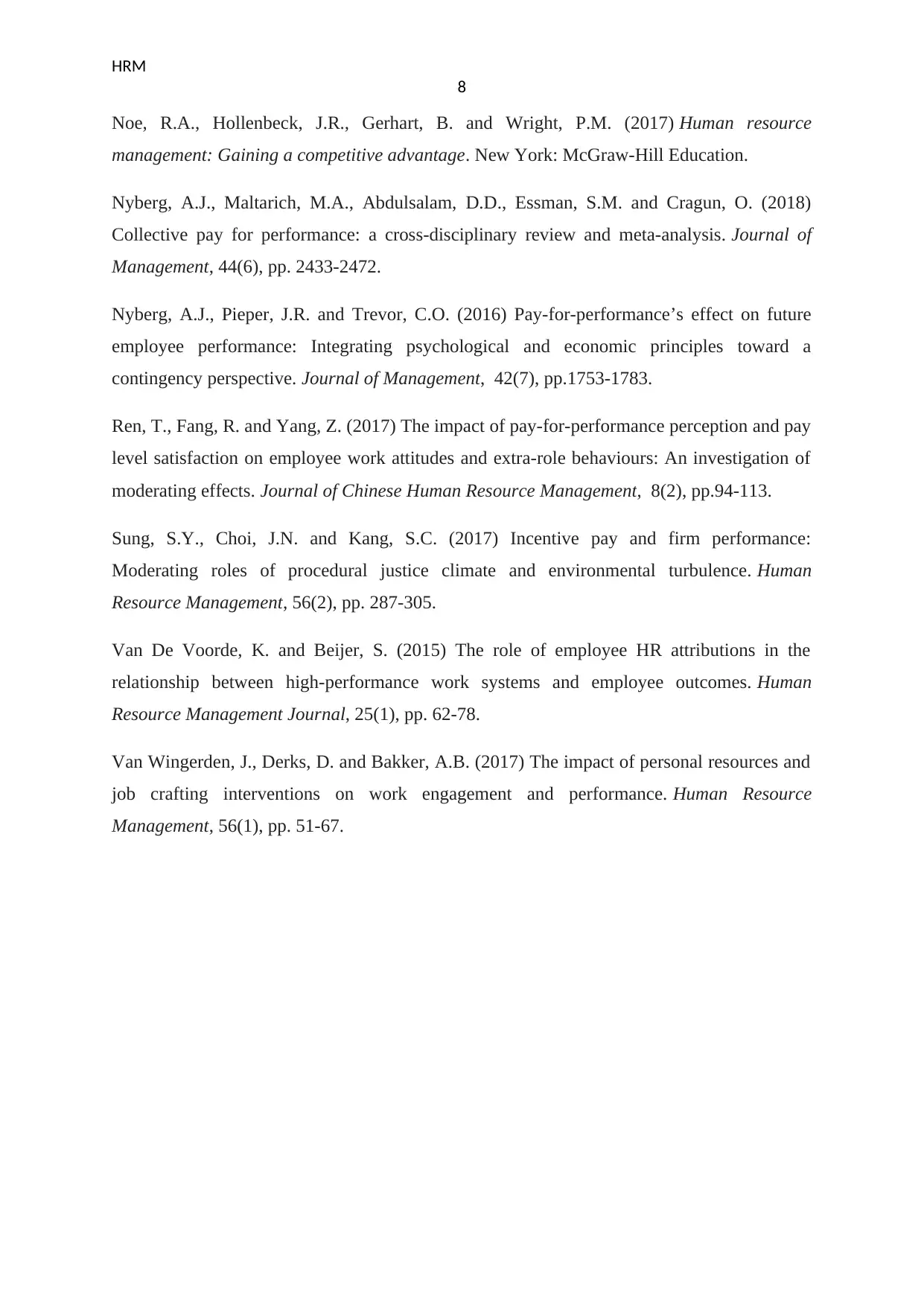
HRM
8
Noe, R.A., Hollenbeck, J.R., Gerhart, B. and Wright, P.M. (2017) Human resource
management: Gaining a competitive advantage. New York: McGraw-Hill Education.
Nyberg, A.J., Maltarich, M.A., Abdulsalam, D.D., Essman, S.M. and Cragun, O. (2018)
Collective pay for performance: a cross-disciplinary review and meta-analysis. Journal of
Management, 44(6), pp. 2433-2472.
Nyberg, A.J., Pieper, J.R. and Trevor, C.O. (2016) Pay-for-performance’s effect on future
employee performance: Integrating psychological and economic principles toward a
contingency perspective. Journal of Management, 42(7), pp.1753-1783.
Ren, T., Fang, R. and Yang, Z. (2017) The impact of pay-for-performance perception and pay
level satisfaction on employee work attitudes and extra-role behaviours: An investigation of
moderating effects. Journal of Chinese Human Resource Management, 8(2), pp.94-113.
Sung, S.Y., Choi, J.N. and Kang, S.C. (2017) Incentive pay and firm performance:
Moderating roles of procedural justice climate and environmental turbulence. Human
Resource Management, 56(2), pp. 287-305.
Van De Voorde, K. and Beijer, S. (2015) The role of employee HR attributions in the
relationship between high‐performance work systems and employee outcomes. Human
Resource Management Journal, 25(1), pp. 62-78.
Van Wingerden, J., Derks, D. and Bakker, A.B. (2017) The impact of personal resources and
job crafting interventions on work engagement and performance. Human Resource
Management, 56(1), pp. 51-67.
8
Noe, R.A., Hollenbeck, J.R., Gerhart, B. and Wright, P.M. (2017) Human resource
management: Gaining a competitive advantage. New York: McGraw-Hill Education.
Nyberg, A.J., Maltarich, M.A., Abdulsalam, D.D., Essman, S.M. and Cragun, O. (2018)
Collective pay for performance: a cross-disciplinary review and meta-analysis. Journal of
Management, 44(6), pp. 2433-2472.
Nyberg, A.J., Pieper, J.R. and Trevor, C.O. (2016) Pay-for-performance’s effect on future
employee performance: Integrating psychological and economic principles toward a
contingency perspective. Journal of Management, 42(7), pp.1753-1783.
Ren, T., Fang, R. and Yang, Z. (2017) The impact of pay-for-performance perception and pay
level satisfaction on employee work attitudes and extra-role behaviours: An investigation of
moderating effects. Journal of Chinese Human Resource Management, 8(2), pp.94-113.
Sung, S.Y., Choi, J.N. and Kang, S.C. (2017) Incentive pay and firm performance:
Moderating roles of procedural justice climate and environmental turbulence. Human
Resource Management, 56(2), pp. 287-305.
Van De Voorde, K. and Beijer, S. (2015) The role of employee HR attributions in the
relationship between high‐performance work systems and employee outcomes. Human
Resource Management Journal, 25(1), pp. 62-78.
Van Wingerden, J., Derks, D. and Bakker, A.B. (2017) The impact of personal resources and
job crafting interventions on work engagement and performance. Human Resource
Management, 56(1), pp. 51-67.
⊘ This is a preview!⊘
Do you want full access?
Subscribe today to unlock all pages.

Trusted by 1+ million students worldwide
1 out of 9